
|
It brightened rapidly in December. Now it is bright as 8.9 mag (Mar. 26, Michael Mattiazzo). It will approach to Earth down to 0.46 a.u. in April, and it will be observable at 8.5 mag in excellent condition.
Date(TT) R.A. (2000) Decl. Delta r Elong. m1 Best Time(A, h)
Apr. 3 19 41.97 0 2.6 0.861 1.159 76 9.1 4:18 (304, 39)
Apr. 10 19 5.93 6 38.8 0.671 1.216 91 8.9 4:07 (313, 52)
|
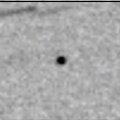
|
Now it is 10.6 mag (Mar. 25, Chris Wyatt). Appearing in the morning sky in the Southern Hemisphere. In the Northern Hemisphere, it will appear in the morning sky in June.
Date(TT) R.A. (2000) Decl. Delta r Elong. m1 Best Time(A, h)
Apr. 3 22 56.94 -9 57.9 2.167 1.416 31 11.6 4:18 (279, -4)
Apr. 10 23 19.24 -8 21.8 2.157 1.424 32 11.6 4:07 (277, -5)
|
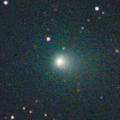
|
It brightened rapidly. Now it is very bright as 12.5 mag (Mar. 24, Chris Wyatt). It stays observable at 11 mag in good condition for a long time from spring to summer.
Date(TT) R.A. (2000) Decl. Delta r Elong. m1 Best Time(A, h)
Apr. 3 14 3.05 34 19.8 1.535 2.365 136 11.9 1:19 ( 0, 89)
Apr. 10 13 59.35 34 24.2 1.495 2.326 136 11.7 0:48 ( 0, 89)
|
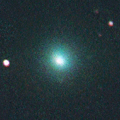
|
It brightened up to 10.5 mag in early March (Mar. 8, Bob King). Now it is fading. In the Northern Hemisphere, it stays observable in the evening low sky until early June while the comet will be fading. It is not observable in the Southern Hemisphere.
Date(TT) R.A. (2000) Decl. Delta r Elong. m1 Best Time(A, h)
Apr. 3 2 25.89 31 30.6 1.747 1.088 34 12.1 19:48 (118, 16)
Apr. 10 3 5.15 33 11.4 1.807 1.159 36 12.4 19:55 (119, 18)
|

|
It brightened up to 11.6 mag in winter (Feb. 18, Thomas Lehmann). Now it is fading. But it is still bright as 13.5 mag (Mar. 25, Chris Wyatt). In the Southern Hemisphere, it stays observable in good condition after this. In the Northern Hemisphere, it will never be observable after this.
Date(TT) R.A. (2000) Decl. Delta r Elong. m1 Best Time(A, h)
Apr. 3 3 45.54 -68 18.0 2.271 2.312 79 12.9 19:48 ( 23,-26)
Apr. 10 3 55.22 -65 9.9 2.350 2.370 78 13.0 19:55 ( 28,-27)
|
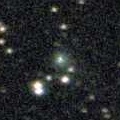
|
Now it is 13.2 mag (Mar. 29, Thomas Lehmann). It will brighten up to 10 mag in winter in 2022. In the Northern Hemisphere, it stays observable in good condition for a long time. In the Southern Hemisphere, it is not observable until November.
Date(TT) R.A. (2000) Decl. Delta r Elong. m1 Best Time(A, h)
Apr. 3 2 23.66 51 5.9 4.934 4.359 50 12.9 19:48 (136, 25)
Apr. 10 2 36.54 50 59.5 4.954 4.324 46 12.9 19:55 (138, 22)
|
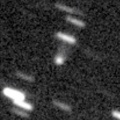
|
Now it is 14.8 mag (Mar. 25, Chris Wyatt). It is expected to brighten up to 13 mag from spring to summer. But actually, it is fainter than this ephemeris recently. In the Southern Hemisphere, it stays observable in good condition for a long time. In the Northern Hemisphere, it is not observable until July in 2022.
Date(TT) R.A. (2000) Decl. Delta r Elong. m1 Best Time(A, h)
Apr. 3 19 12.15 -67 1.9 3.488 3.670 92 13.4 4:18 (347,-15)
Apr. 10 19 28.46 -68 45.4 3.415 3.658 96 13.3 4:07 (348,-16)
|
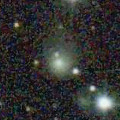
|
Now it is 13.3 mag (Mar. 17, Toshihiko Ikemura, Hirohisa Sato). It is expected to be observable at 5-6 mag for a long time from 2022 to 2023. In the Northern Hemisphere, it is not observable at the high light from 2022 summer to 2023 summer. In the Southern Hemisphere, it stays extremely low for a while. But it will be observable in good condition at the high light.
Date(TT) R.A. (2000) Decl. Delta r Elong. m1 Best Time(A, h)
Apr. 3 18 28.06 39 35.2 6.626 6.711 90 13.4 4:18 (249, 73)
Apr. 10 18 27.43 40 13.3 6.515 6.655 93 13.3 4:07 (244, 76)
|
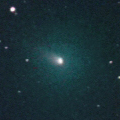
|
It brightening very rapidly up to 12.5 mag in early February (Feb. 8, Michael Jager). Now it is fading. But it is still bright as 13.0 mag (Mar. 27, Thomas Lehmann). In the Northern Hemisphere, it is observable only until early April. In the Southern Hemisphere, it stays observable after this while the comet will be fading.
Date(TT) R.A. (2000) Decl. Delta r Elong. m1 Best Time(A, h)
Apr. 3 4 12.18 -7 58.7 1.465 1.167 52 13.5 19:48 ( 69, 15)
Apr. 10 4 12.22 -10 10.3 1.605 1.192 47 14.1 19:55 ( 73, 6)
|
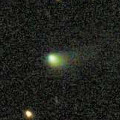
|
Now it is 15.0 mag (Mar. 20, F. Kugel, J.-G. Bosch). It stays 13-14 mag from 2020 to 2021. It will be observable in good condition after this in the Southern Hemisphere. It locates somewhat low in the Northern Hemisphere.
Date(TT) R.A. (2000) Decl. Delta r Elong. m1 Best Time(A, h)
Apr. 3 19 2.55 -24 13.2 2.711 2.872 88 13.9 4:18 (330, 24)
Apr. 10 19 9.42 -24 35.0 2.621 2.875 94 13.8 4:07 (332, 25)
|

|
Now it is 13.5 mag (Mar. 28, Thomas Lehmann). Brightenening very rapidly. It will brighten up to 11 mag from May to August. In the Southern Hemisphere, it stays observable in excellent condition for a long time. In the Northern Hemisphere, it stays observable in good condition for a while. But it becomes extremely low after July.
Date(TT) R.A. (2000) Decl. Delta r Elong. m1 Best Time(A, h)
Apr. 3 17 57.21 8 55.4 0.795 1.399 101 14.2 4:18 (332, 61)
Apr. 10 18 19.41 8 15.9 0.734 1.362 102 13.9 4:07 (330, 60)
|
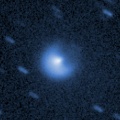
|
Now it is 13.2 mag (Mar. 6, Thomas Lehmann). It is already unobservable in the Southern Hemisphere. It will be unobservable in April also in the Northern Hemisphere.
Date(TT) R.A. (2000) Decl. Delta r Elong. m1 Best Time(A, h)
Apr. 3 2 56.18 25 12.5 6.642 5.869 36 13.9 19:48 (109, 18)
Apr. 10 3 1.76 25 29.4 6.706 5.871 31 13.9 19:55 (112, 13)
|
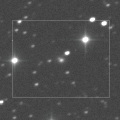
|
Now it is 13.3 mag (Mar. 24, Chris Wyatt). It stays 13.5 mag until early summer. In the Southern Hemisphere, it stays observable in good condition for a long time. It is getting higher slowly also in the Northern Hemisphere.
Date(TT) R.A. (2000) Decl. Delta r Elong. m1 Best Time(A, h)
Apr. 3 17 13.14 -38 32.0 2.856 3.358 111 14.0 4:18 (358, 16)
Apr. 10 16 59.95 -37 51.9 2.728 3.356 121 13.9 3:48 ( 0, 17)
|
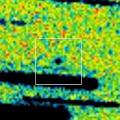
|
It was expected to brighten up to 13 mag from spring to summer. But actually, now it is extremely faint as 19.0 mag (Mar. 22, A. C. Gilmore, P. M. Kilmartin). In the Southern Hemisphere, it stays observable in good condition for a long time. In the Northern Hemisphere, it is not observable until late August.
Date(TT) R.A. (2000) Decl. Delta r Elong. m1 Best Time(A, h)
Apr. 3 21 24.71 -38 55.0 1.950 1.766 64 14.4 4:18 (315, -5)
Apr. 10 21 54.29 -41 1.2 1.846 1.721 66 14.2 4:07 (315, -9)
|
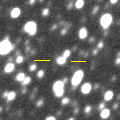
|
Now it is 14.6 mag (Mar. 26, Thomas Lehmann). It is expected to brighten up to 11.5 mag in 2022. It is observable in excellent condition in the Southern Hemisphere. In the Northern Hemisphere, it is observable in the low sky until May.
Date(TT) R.A. (2000) Decl. Delta r Elong. m1 Best Time(A, h)
Apr. 3 8 0.16 -33 21.9 5.119 5.508 107 14.4 19:48 ( 8, 21)
Apr. 10 8 1.82 -32 17.2 5.140 5.473 104 14.3 19:55 ( 15, 21)
|
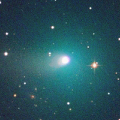
|
Brightened rapidly, and it brightened up to 9.7 mag in November (Nov. 15, Chris Wyatt). Now it is fading. It has already faded down to 14.1 mag (Mar. 29, Thomas Lehmann). In the Northern Hemisphere, it stays observable in good condition for a long time. In the Southern Hemisphere, it locates extremely low after this.
Date(TT) R.A. (2000) Decl. Delta r Elong. m1 Best Time(A, h)
Apr. 3 5 47.36 40 27.7 1.999 1.991 75 14.9 19:48 (112, 57)
Apr. 10 6 6.80 40 2.2 2.112 2.041 72 15.2 19:55 (112, 54)
|
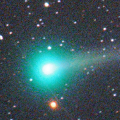
|
It brightened up to 5.6 mag in early December (Dec. 9, Marco Goiato). In mid December, it was visible at about 3 mag in the SOHO spacecraft images (Dec. 18, Hirohisa Sato). It is appearing in the morning sky soon.
Date(TT) R.A. (2000) Decl. Delta r Elong. m1 Best Time(A, h)
Apr. 3 23 16.74 8 34.4 3.098 2.212 23 14.9 4:18 (261, 2)
Apr. 10 23 26.10 9 44.4 3.165 2.315 26 15.1 4:07 (261, 4)
|

|
It has not been observed yet in this apparition. It will brighten up to 10 mag from summer to autumn, and it will be observable in excellent condition. It is appearing in the morning sky soon.
Date(TT) R.A. (2000) Decl. Delta r Elong. m1 Best Time(A, h)
Apr. 3 22 35.71 -4 0.5 2.988 2.236 34 15.2 4:18 (277, 3)
Apr. 10 22 49.82 -2 42.0 2.903 2.194 37 15.0 4:07 (276, 5)
|
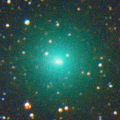
|
It brightened up to 8.2 mag in autumn (Oct. 13, Chris Wyatt). It faded down to 13.0 mag in February (Feb. 14, Sandor Szabo). It is not observable after this.
Date(TT) R.A. (2000) Decl. Delta r Elong. m1 Best Time(A, h)
Apr. 3 1 36.43 8 35.6 3.267 2.300 12 15.0 19:48 (106, -7)
Apr. 10 1 49.21 9 54.0 3.331 2.346 8 15.2 19:55 (110,-10)
|
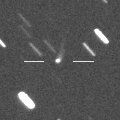
|
It will brighten up to 14.5 mag from spring to summer. In the Southern Hemisphere, it stays observable in excellent condition for a long time. In the Northern Hemisphere, it is not observable after this.
Date(TT) R.A. (2000) Decl. Delta r Elong. m1 Best Time(A, h)
Apr. 3 23 32.08 -46 55.4 3.101 2.654 54 15.1 4:18 (309,-29)
Apr. 10 23 46.78 -48 43.5 3.009 2.649 59 15.0 4:07 (311,-30)
|
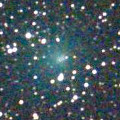
|
It brightened up to 10.5 mag in early February (Feb. 6, Marco Goiato). Now it is fading rapidly. It has already faded down to 15.6 mag (Mar. 29, Thomas Lehmann). In the Northern Hemisphere, it stays observable for a long time after this. In the Southern Heimsphere, it will never be observable again.
Date(TT) R.A. (2000) Decl. Delta r Elong. m1 Best Time(A, h)
Apr. 3 4 59.54 49 26.6 1.822 1.729 68 15.1 19:48 (128, 49)
Apr. 10 5 1.98 51 0.8 1.990 1.786 63 15.5 19:55 (130, 44)
|
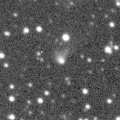
|
Now it is 15.8 mag (Jan. 14, Slooh.com Chile Observatory, La Dehesa). It stays 14-15 mag until the end of 2021. In the Southern Hemisphere, it stays observable in good condition for a long time. In the Northern Hemisphere, it is not observable until June.
Date(TT) R.A. (2000) Decl. Delta r Elong. m1 Best Time(A, h)
Apr. 3 22 55.65 -40 41.5 4.859 4.327 52 15.1 4:18 (306,-21)
Apr. 10 23 2.84 -39 48.5 4.800 4.328 56 15.1 4:07 (306,-19)
|

|
Now it is 14.7 mag (Mar. 12, D. Buczynski). It will stay at 14-15 mag for a long time from 2021 to 2022. It stays observable in good condition after this while brightening gradually.
Date(TT) R.A. (2000) Decl. Delta r Elong. m1 Best Time(A, h)
Apr. 3 18 21.29 1 45.2 5.046 5.256 96 15.2 4:18 (327, 52)
Apr. 10 18 19.11 1 33.2 4.916 5.240 103 15.2 4:07 (334, 54)
|
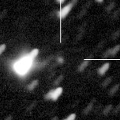
|
Now it is 14.7 mag (Mar. 26, Thomas Lehmann). It stays 15 mag until summer. In the Southern Hemisphere, it stays observable in good condition until June. In the Northern Hemisphere, it is observable in the low sky from March to May.
Date(TT) R.A. (2000) Decl. Delta r Elong. m1 Best Time(A, h)
Apr. 3 6 26.53 -32 3.2 2.137 2.330 88 15.3 19:48 ( 28, 17)
Apr. 10 6 35.95 -27 46.9 2.139 2.287 85 15.2 19:55 ( 35, 18)
|
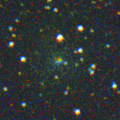
|
Now it is 15.8 mag (Jan. 16, Slooh.com Canary Islands Observatory). It is not observable until June.
Date(TT) R.A. (2000) Decl. Delta r Elong. m1 Best Time(A, h)
Apr. 3 0 17.09 10 58.8 3.084 2.106 9 15.3 4:18 (250, -8)
Apr. 10 0 31.25 13 0.9 3.086 2.115 11 15.3 4:07 (249, -7)
|

|
It had been observed as 8-9 mag for a long time in 2020. Now it is fading. It has already faded down to 16.4 mag (Mar. 27, Thomas Lehmann). It will be observable in good condition after this in the Southern Hemisphere. It locates extremely low after this in the Northern Hemisphere.
Date(TT) R.A. (2000) Decl. Delta r Elong. m1 Best Time(A, h)
Apr. 3 17 46.15 -38 58.0 3.876 4.252 105 15.4 4:18 (351, 15)
Apr. 10 17 44.25 -40 0.0 3.837 4.317 112 15.4 4:07 (355, 15)
|
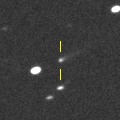
|
Now it is 15.2 mag (Mar. 24, F. Kugel, J.-G. Bosch). It will brighten up to 13 mag in 2022. In 2021, it is observable at 15-16 mag in good condition.
Date(TT) R.A. (2000) Decl. Delta r Elong. m1 Best Time(A, h)
Apr. 3 13 29.33 -1 7.1 2.717 3.704 169 15.4 0:45 ( 0, 54)
Apr. 10 13 24.71 -0 47.1 2.693 3.688 172 15.4 0:13 ( 0, 54)
|
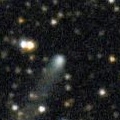
|
Now it is 15.4 mag (Mar. 16, Toshihiko Ikemura, Hirohisa Sato). It stays 15-16 mag until spring. In the Northern Hemisphere, it stays observable in good condition for a long time. In the Southern Hemisphere, it will be observable in the extremely low sky only in next spring.
Date(TT) R.A. (2000) Decl. Delta r Elong. m1 Best Time(A, h)
Apr. 3 19 21.22 40 36.5 5.116 5.047 80 15.6 4:18 (248, 62)
Apr. 10 19 19.39 42 32.2 5.083 5.073 83 15.7 4:07 (243, 66)
|
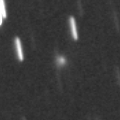
|
Now it is 16.3 mag (Mar. 18, Toshihiko Ikemura, Hirohisa Sato). In the Northern Hemisphere, it stays observable at 15 mag for a long time from spring to early 2022. In the Southern Hemisphere, it is not observable until the end of 2021.
Date(TT) R.A. (2000) Decl. Delta r Elong. m1 Best Time(A, h)
Apr. 3 20 17.87 63 21.3 3.406 3.301 75 15.9 4:18 (211, 49)
Apr. 10 20 13.70 66 13.4 3.352 3.273 76 15.9 4:07 (205, 50)
|
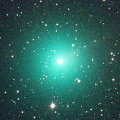
|
It brightened up to 7.3 mag in November (Nov. 7, Marco Goiato). Now it is fading. It has already faded down to 16.0 mag (Mar. 17, Toshihiko Ikemura, Hirohisa Sato). In the Northern Hemisphere, it stays observable in excellent condition for a long time. In the Southern Hemisphere, it stays locating extremely low after this.
Date(TT) R.A. (2000) Decl. Delta r Elong. m1 Best Time(A, h)
Apr. 3 7 10.53 44 36.4 2.306 2.517 90 15.9 19:48 (127, 71)
Apr. 10 7 22.73 43 52.1 2.457 2.590 86 16.2 19:55 (121, 68)
|

|
Now it is not observable. It will be observable in June. But it will fade down to 17 mag at that time.
Date(TT) R.A. (2000) Decl. Delta r Elong. m1 Best Time(A, h)
Apr. 3 23 51.25 -0 37.5 2.542 1.600 15 15.9 4:18 (264,-10)
Apr. 10 0 9.39 2 6.2 2.547 1.617 17 15.9 4:07 (261, -9)
|
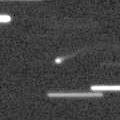
|
First return of a new periodic comet which brightened up to 14-15 mag in 2006. Now it is 15.3 mag (Mar. 18, Toshihiko Ikemura, Hirohisa Sato). It will be fading rapidly after this, and it will be fainter than 18 mag in May.
Date(TT) R.A. (2000) Decl. Delta r Elong. m1 Best Time(A, h)
Apr. 3 13 19.96 20 25.3 0.943 1.890 153 16.1 0:36 ( 0, 75)
Apr. 10 13 18.63 21 16.9 0.981 1.919 150 16.3 0:07 ( 0, 76)
|
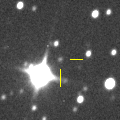
|
Now it is 16.3 mag (Mar. 16, Toshihiko Ikemura, Hirohisa Sato). It is expected to brighten up to 13 mag in 2022. In the Southern Hemisphere, it stays observable in good condition for a long time. In the Northern Hemisphere, it stays observable until June, but it will not be observable at the high light.
Date(TT) R.A. (2000) Decl. Delta r Elong. m1 Best Time(A, h)
Apr. 3 13 25.83 -20 39.8 4.161 5.121 162 16.2 0:42 ( 0, 34)
Apr. 10 13 17.36 -20 48.8 4.093 5.075 167 16.1 0:06 ( 0, 34)
|
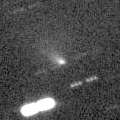
|
Now it is 16.0 mag (Mar. 10, Toshihiko Ikemura, Hirohisa Sato). It will be fading after this. In the Northern Hemisphere, it will be getting lower gradually, and will be too low to observe in May. It will be getting higher gradually in the Southern Hemisphere.
Date(TT) R.A. (2000) Decl. Delta r Elong. m1 Best Time(A, h)
Apr. 3 5 18.65 10 38.7 1.392 1.360 67 16.2 19:48 ( 73, 39)
Apr. 10 5 43.45 8 34.2 1.439 1.389 66 16.3 19:55 ( 73, 36)
|

|
Now it is 15.4 mag (Mar. 17, Toshihiko Ikemura, Hirohisa Sato). In the Northern Hemisphere, it stays observable for a long time while it is getting fainter slowly. In the Southern Hemisphere, it will never be observable again.
Date(TT) R.A. (2000) Decl. Delta r Elong. m1 Best Time(A, h)
Apr. 3 15 45.18 69 19.7 5.332 5.587 99 16.2 3:00 (180, 56)
Apr. 10 15 30.52 69 37.3 5.390 5.635 99 16.2 2:18 (180, 55)
|
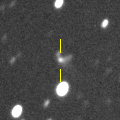
|
Now it is 15.5 mag (Mar. 14, Toshihiko Ikemura, Hirohisa Sato). It stays observable at 16 mag from 2021 to 2022.
Date(TT) R.A. (2000) Decl. Delta r Elong. m1 Best Time(A, h)
Apr. 3 14 16.33 -18 23.0 3.993 4.916 154 16.4 1:32 ( 0, 36)
Apr. 10 14 12.16 -16 56.8 3.933 4.900 163 16.4 1:01 ( 0, 38)
|
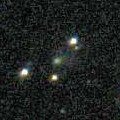
|
Now it is 16.2 mag (Mar. 16, Toshihiko Ikemura, Hirohisa Sato). It stays observable at 16 mag in good condition from April to May.
Date(TT) R.A. (2000) Decl. Delta r Elong. m1 Best Time(A, h)
Apr. 3 15 31.87 15 53.0 1.556 2.366 134 16.6 2:48 ( 0, 71)
Apr. 10 15 6.10 15 10.9 1.479 2.364 143 16.5 1:55 ( 0, 70)
|
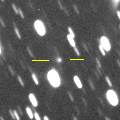
|
Now it is 16.5 mag (Feb. 9, Toshihiko Ikemura, Hirohisa Sato). It is observable at 16 mag from 2020 to 2021. In the Southern Hemisphere, it is not observable until summer.
Date(TT) R.A. (2000) Decl. Delta r Elong. m1 Best Time(A, h)
Apr. 3 23 6.02 42 34.0 6.633 5.951 43 16.5 4:18 (233, 22)
Apr. 10 23 9.17 42 38.3 6.628 5.953 44 16.5 4:07 (234, 25)
|
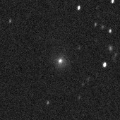
|
Now it is 16.7 mag (Mar. 14, Toshihiko Ikemura, Hirohisa Sato). It is observable at 16.5 mag from spring in 2020 to summer in 2021.
Date(TT) R.A. (2000) Decl. Delta r Elong. m1 Best Time(A, h)
Apr. 3 17 39.40 -13 22.0 4.379 4.783 107 16.5 4:18 (348, 41)
Apr. 10 17 34.11 -13 50.0 4.272 4.797 116 16.5 4:07 (355, 41)
|
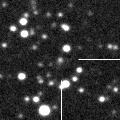
|
Now it is 16.2 mag (Mar. 16, Toshihiko Ikemura, Hirohisa Sato). It stays at 16-17 mag from 2020 to 2021. In the Northern Hemisphere, it stays observable in good condition for a long time. It is not observable in the Southern Hemisphere.
Date(TT) R.A. (2000) Decl. Delta r Elong. m1 Best Time(A, h)
Apr. 3 19 47.10 39 39.3 9.019 8.821 75 16.7 4:18 (249, 57)
Apr. 10 19 47.41 40 41.3 8.965 8.822 78 16.7 4:07 (248, 61)
|
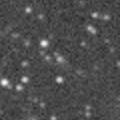
|
Now it is 17.0 mag (Mar. 4, D. Husar). It will brighten up to 16.5 mag in summer.
Date(TT) R.A. (2000) Decl. Delta r Elong. m1 Best Time(A, h)
Apr. 3 17 37.30 -32 10.1 4.599 4.996 107 16.8 4:18 (352, 22)
Apr. 10 17 36.34 -31 27.6 4.479 4.984 114 16.7 4:07 (356, 23)
|
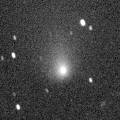
|
First return of a new periodic comet which brightened up to 13 mag in 2009. It brightened up to 11.7 mag in January (Jan. 10, Marco Goiato). Now it is fading. It has already faded down to 16.9 mag (Mar. 29, Thomas Lehmann). It stays observable in good condition while the comet will be fading after this.
Date(TT) R.A. (2000) Decl. Delta r Elong. m1 Best Time(A, h)
Apr. 3 8 15.57 27 45.5 1.104 1.688 106 16.8 19:48 ( 30, 82)
Apr. 10 8 32.04 27 16.2 1.201 1.733 103 17.2 19:55 ( 48, 79)
|
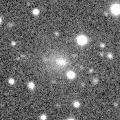
|
Brightened very rapidly up to 15.0 mag (Feb. 4, Michael Jager). Now it is fading. It hasl already faded down to 16.9 mag (Mar. 14, Toshihiko Ikemura, Hirohisa Sato). It is observable in good condition in the Northern Hemisphere. It locates low in the Southern Hemisphere.
Date(TT) R.A. (2000) Decl. Delta r Elong. m1 Best Time(A, h)
Apr. 3 5 34.05 28 5.6 2.135 2.044 71 16.9 19:48 ( 93, 51)
Apr. 10 5 50.66 27 53.0 2.227 2.071 67 17.1 19:55 ( 95, 48)
|
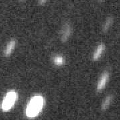
|
Now it is 17.0 mag (Apr. 1, Michael Jager). Although it is an asteroid, it is brightening rapidly. It may brighten up to 11 mag in 2023. In the Northern Hemisphere, it stays observable in good condition for a long time. It locates extremely low in the Southern Hemisphere.
Date(TT) R.A. (2000) Decl. Delta r Elong. m1 Best Time(A, h)
Apr. 3 18 33.16 44 21.0 7.003 7.058 89 17.0 4:18 (235, 70)
Apr. 10 18 30.53 45 17.2 6.907 7.013 91 16.9 4:07 (227, 73)
|
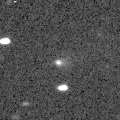
|
First return of a new periodic comet which brightened up to 16 mag in 2014. Now it is 17.0 mag (Mar. 17, Toshihiko Ikemura, Hirohisa Sato). It stays observable at 17 mag in good condition until July.
Date(TT) R.A. (2000) Decl. Delta r Elong. m1 Best Time(A, h)
Apr. 3 12 33.91 12 41.1 1.319 2.290 161 17.0 23:45 ( 0, 68)
Apr. 10 12 27.33 12 14.3 1.317 2.272 156 16.9 23:11 ( 0, 67)
|

|
Now it is 17.7 mag (Mar. 6, ATLAS-MLO, Mauna Loa). It will be fading slowly.
Date(TT) R.A. (2000) Decl. Delta r Elong. m1 Best Time(A, h)
Apr. 3 18 24.40 -17 1.9 7.269 7.461 97 17.0 4:18 (336, 34)
Apr. 10 18 22.04 -16 40.1 7.168 7.485 104 16.9 4:07 (341, 36)
|
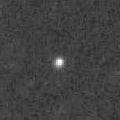
|
Now it is 16.3 mag (Mar. 14, Toshihiko Ikemura, Hirohisa Sato). It is expected to brighten up to 10 mag in 2023. In the Northern Hemisphere, it stays observable in good condition until 2023 autumn. In the Southern Hemipshere, it stays extremely low until mid July, then it becomes unobservable for a while. But it becomes observable in good condition after 2023 summer.
Date(TT) R.A. (2000) Decl. Delta r Elong. m1 Best Time(A, h)
Apr. 3 12 45.04 37 19.1 6.837 7.604 137 17.0 0:01 (180, 88)
Apr. 10 12 39.74 37 51.2 6.826 7.552 133 17.0 23:24 (180, 87)
|
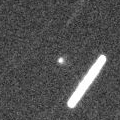
|
Brightening rapidly. Now it is 17.0 mag (Mar. 24, F. Kugel, J.-G. Bosch). It stays 17 mag until April. It is observable in excellent condition in the Northern Hemisphere. It locates somewhat low in the Southern Hemisphere.
Date(TT) R.A. (2000) Decl. Delta r Elong. m1 Best Time(A, h)
Apr. 3 11 17.24 29 6.4 1.492 2.343 139 17.4 22:28 ( 0, 84)
Apr. 10 10 57.29 33 4.5 1.612 2.362 127 17.5 21:41 ( 0, 88)
|
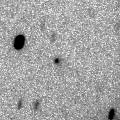
|
Now it is 17.4 mag (Mar. 18, Toshihiko Ikemura, Hirohisa Sato). It will approach to Earth down to 0.2 a.u. in December, and it is expected to brighten up to 4 mag. In the Northern Hemisphere, it stays observable in good condition for a long time until December while the comet is brightening gradually. In the Southern Hemisphere, it is not observable until mid December.
Date(TT) R.A. (2000) Decl. Delta r Elong. m1 Best Time(A, h)
Apr. 3 12 44.39 60 48.7 3.621 4.129 113 17.5 0:01 (180, 64)
Apr. 10 12 26.01 61 29.5 3.598 4.052 110 17.4 23:09 (180, 64)
|
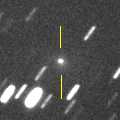
|
It brightened rapidly and became brighter than expected. Now it is 16.9 mag (Mar. 18, Toshihiko Ikemura, Hirohisa Sato). It is observable in good condition in the Northern Hemisphere. It locates somewhat low in the Southern Hemisphere.
Date(TT) R.A. (2000) Decl. Delta r Elong. m1 Best Time(A, h)
Apr. 3 5 26.34 19 42.0 2.211 2.073 68 17.4 19:48 ( 82, 46)
Apr. 10 5 41.37 19 16.5 2.302 2.097 65 17.6 19:55 ( 85, 42)
|

|
First return of a new periodic comet observed at 19 mag in 2015. Now it is 17.8 mag (Mar. 4, Giuseppe Pappa). It will brighten up to 17 mag in early summer, and it will be observable in good condition.
Date(TT) R.A. (2000) Decl. Delta r Elong. m1 Best Time(A, h)
Apr. 3 17 54.29 -11 18.0 0.906 1.505 104 17.6 4:18 (343, 42)
Apr. 10 18 11.90 -11 17.2 0.862 1.497 106 17.4 4:07 (343, 42)
|

|
Now it is 17.1 mag (Mar. 18, Toshihiko Ikemura, Hirohisa Sato). It brightened rapidly. It stays 17-18 mag for a long time from 2021 to 2022. In the Southern Hemisphere, it stays observable in good condition for a long time. In the Northern Hemisphere, it is observable only until May.
Date(TT) R.A. (2000) Decl. Delta r Elong. m1 Best Time(A, h)
Apr. 3 8 23.57 -7 3.4 5.101 5.586 114 17.5 19:48 ( 5, 48)
Apr. 10 8 20.62 -7 7.2 5.189 5.570 107 17.5 19:55 ( 18, 46)
|
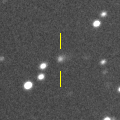
|
Now it is 17.8 mag (Mar. 16, Toshihiko Ikemura, Hirohisa Sato). Fading slowly. In 2021, it stays observable at 17-18 mag in good condition until early summer.
Date(TT) R.A. (2000) Decl. Delta r Elong. m1 Best Time(A, h)
Apr. 3 13 5.81 -17 36.7 5.965 6.942 166 17.5 0:22 ( 0, 37)
Apr. 10 13 3.80 -17 3.1 5.967 6.957 170 17.5 23:48 ( 0, 38)
|
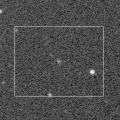
|
Now it is 18.2 mag (Mar. 12, Thomas Lehmann). It is expected to brighten up to 12.5 mag in 2022. In the Southern Hemisphere, it stays observable in good condition for a long time. In the Northern Hemisphere, it is not observable until 2022 autumn.
Date(TT) R.A. (2000) Decl. Delta r Elong. m1 Best Time(A, h)
Apr. 3 2 51.01 -42 32.8 6.239 5.729 55 17.6 19:48 ( 52,-20)
Apr. 10 2 54.13 -42 14.1 6.194 5.679 55 17.5 19:55 ( 55,-25)
|

|
It has not been observed yet in this apparition. In the Southern Hemissphere, appearing in the morning sky. It is already fading.
Date(TT) R.A. (2000) Decl. Delta r Elong. m1 Best Time(A, h)
Apr. 3 22 40.36 -11 48.3 2.587 1.874 36 17.5 4:18 (283, -2)
Apr. 10 22 56.38 -10 40.5 2.577 1.905 38 17.7 4:07 (282, -1)
|
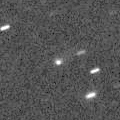
|
Now it is 17.4 mag (Mar. 14, Toshihiko Ikemura, Hirohisa Sato). It stays 17-18 mag for a long time from 2021 to 2023.
Date(TT) R.A. (2000) Decl. Delta r Elong. m1 Best Time(A, h)
Apr. 3 10 41.50 12 12.7 4.067 4.910 143 17.6 21:54 ( 0, 67)
Apr. 10 10 39.40 12 18.5 4.127 4.903 136 17.6 21:24 ( 0, 67)
|

|
Now it is 17.6 mag (Mar. 19, ATLAS-MLO, Mauna Loa). It stays observable at 17-18 mag for a long time until 2024.
Date(TT) R.A. (2000) Decl. Delta r Elong. m1 Best Time(A, h)
Apr. 3 15 21.47 -10 57.0 8.420 9.225 141 17.6 2:37 ( 0, 44)
Apr. 10 15 17.58 -10 31.6 8.337 9.214 149 17.6 2:06 ( 0, 44)
|
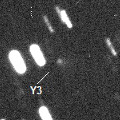
|
Now it is 16.8 mag (Mar. 14, Toshihiko Ikemura, Hirohisa Sato). It will be fading after this.
Date(TT) R.A. (2000) Decl. Delta r Elong. m1 Best Time(A, h)
Apr. 3 14 39.98 39 52.0 1.710 2.457 128 17.8 1:56 (180, 85)
Apr. 10 14 30.76 43 47.2 1.786 2.504 125 17.9 1:19 (180, 81)
|
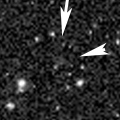
|
It stays 17-18 mag for a long time until 2026. In the Southern Hemisphere, it stays sobservable in good condition for a long time. It is not observable in the Northern Hemisphere. Now it is 19.7 mag (Mar. 13, A. C. Gilmore, P. M. Kilmartin), fainter than this ephemeris.
Date(TT) R.A. (2000) Decl. Delta r Elong. m1 Best Time(A, h)
Apr. 3 8 56.92 -56 19.2 11.087 11.493 111 17.8 20:09 ( 0, -1)
Apr. 10 8 53.96 -55 57.8 11.091 11.477 110 17.8 19:55 ( 2, -1)
|
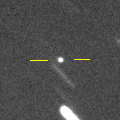
|
Now it is 16.9 mag (Mar. 10, Toshihiko Ikemura, Hirohisa Sato). It will be fading after this, and will be fainter than 18 mag in April. In the Northern Hemisphere, it stays observable in good condition for a long time after this. In the Southern Hemisphere, it will never be unobservable after this.
Date(TT) R.A. (2000) Decl. Delta r Elong. m1 Best Time(A, h)
Apr. 3 4 22.47 44 48.2 2.063 1.805 61 17.8 19:48 (122, 42)
Apr. 10 4 47.31 45 23.6 2.155 1.853 59 17.9 19:55 (123, 40)
|
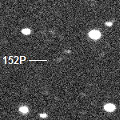
|
Now it is 18.2 mag (Mar. 19, ATLAS-MLO, Mauna Loa). It will brighten up to 16 mag in 2022. In 2021, it stays observable at 18 mag until September.
Date(TT) R.A. (2000) Decl. Delta r Elong. m1 Best Time(A, h)
Apr. 3 13 49.30 2 42.7 2.473 3.441 162 17.9 1:05 ( 0, 58)
Apr. 10 13 45.13 3 7.4 2.443 3.426 166 17.8 0:34 ( 0, 58)
|

|
It will brighten up to 15 mag from summer to autumn, and it will be observable in good condition. It already locates high in the Southern Hemisphere. It will be getting higher gradually also in the Northern Hemisphere.
Date(TT) R.A. (2000) Decl. Delta r Elong. m1 Best Time(A, h)
Apr. 3 21 8.76 -11 26.0 2.949 2.548 57 18.0 4:18 (297, 16)
Apr. 10 21 20.34 -10 44.7 2.857 2.529 61 17.8 4:07 (297, 17)
|

|
Now it is 17.5 mag (Mar. 15, Giuseppe Pappa). It is observable at 18 mag in spring. It is observable in excellent condition in the Southern Hemisphere. It locates low in the Northern Hemisphere.
Date(TT) R.A. (2000) Decl. Delta r Elong. m1 Best Time(A, h)
Apr. 3 13 54.58 -39 13.7 3.710 4.547 142 17.9 1:11 ( 0, 16)
Apr. 10 13 43.17 -37 44.3 3.664 4.555 149 17.9 0:32 ( 0, 17)
|
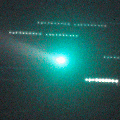
|
It brightened very rapidly in early December, and it brightened up to 10.0 mag in January (Jan. 7, Michael Jager). Now it is fading. However, it brightened in outburst in early March up to 12.9 mag (Mar. 3, Martin Masek). Now it is 14.1 mag (Mar. 15, Thomas Lehmann).
Date(TT) R.A. (2000) Decl. Delta r Elong. m1 Best Time(A, h)
Apr. 3 6 52.58 5 54.2 1.407 1.733 90 17.9 19:48 ( 45, 53)
Apr. 10 7 9.25 6 7.6 1.537 1.805 87 18.6 19:55 ( 51, 50)
|
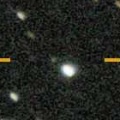
|
Now it is 17.8 mag (Mar. 25, ATLAS-MLO, Mauna Loa). It is expected to brighten up to 12 mag in 2023. In the Northern Hemisphere, it is observable in good condition in 2021. But it is observable only until November in 2022. In the Southern Hemisphere, it locates extremely low in 2021. But it will be observable in good condition at the high light.
Date(TT) R.A. (2000) Decl. Delta r Elong. m1 Best Time(A, h)
Apr. 3 18 50.09 43 3.0 7.357 7.358 86 18.0 4:18 (241, 68)
Apr. 10 18 49.86 43 35.8 7.259 7.310 88 17.9 4:07 (237, 71)
|
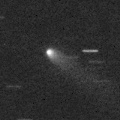
|
Now it is 17.7 mag (Mar. 7, ATLAS-MLO, Mauna Loa). Although it is around the aphelion, it is much brighter than originally predicted.
Date(TT) R.A. (2000) Decl. Delta r Elong. m1 Best Time(A, h)
Apr. 3 10 51.62 10 30.5 4.539 5.405 146 18.1 22:04 ( 0, 65)
Apr. 10 10 48.74 10 37.4 4.608 5.408 139 18.1 21:33 ( 0, 66)
|

|
Marsden group's comet. Three apparitions of this comet was confirmed in 1999, 2004 and 2010. It approached to Sun down to 0.044 a.u. on Feb. 28. After the perihelion passage, it may be observed on the ground from March to April.
Date(TT) R.A. (2000) Decl. Delta r Elong. m1 Best Time(A, h)
Apr. 3 21 11.17 -18 4.1 1.156 1.061 58 24.7 4:18 (301, 11)
Apr. 10 21 5.14 -19 24.7 1.161 1.202 67 25.5 4:07 (306, 14)
|
|
![]()
 88P/Howell
88P/Howell C/2019 T2 ( Lemmon )
C/2019 T2 ( Lemmon ) C/2021 A2 ( NEOWISE )
C/2021 A2 ( NEOWISE ) C/2020 F5 ( MASTER )
C/2020 F5 ( MASTER ) C/2018 U1 ( Lemmon )
C/2018 U1 ( Lemmon ) C/2021 A7 ( NEOWISE )
C/2021 A7 ( NEOWISE ) 17P/Holmes
17P/Holmes C/2017 T2 ( PanSTARRS )
C/2017 T2 ( PanSTARRS ) 117P/Helin-Roman-Alu 1
117P/Helin-Roman-Alu 1 C/2019 K7 ( Smith )
C/2019 K7 ( Smith ) C/2020 M5 ( ATLAS )
C/2020 M5 ( ATLAS ) C/2020 M3 ( ATLAS )
C/2020 M3 ( ATLAS ) 28P/Neujmin 1
28P/Neujmin 1 409P/2020 V1 ( LONEOS-Hill )
409P/2020 V1 ( LONEOS-Hill ) C/2020 Y2 ( ATLAS )
C/2020 Y2 ( ATLAS ) C/2020 N1 ( PanSTARRS )
C/2020 N1 ( PanSTARRS ) C/2018 N2 ( ASASSN )
C/2018 N2 ( ASASSN ) C/2020 H6 ( ATLAS )
C/2020 H6 ( ATLAS ) C/2020 S8 ( Lemmon )
C/2020 S8 ( Lemmon ) C/2019 T3 ( ATLAS )
C/2019 T3 ( ATLAS ) C/2017 Y2 ( PanSTARRS )
C/2017 Y2 ( PanSTARRS ) C/2019 O3 ( Palomar )
C/2019 O3 ( Palomar ) C/2020 O2 ( Amaral )
C/2020 O2 ( Amaral ) 398P/2020 P2 ( Boattini )
398P/2020 P2 ( Boattini ) P/2020 U2 ( PanSTARRS )
P/2020 U2 ( PanSTARRS ) A/2019 U5
A/2019 U5 413P/2020 W4 ( Larson )
413P/2020 W4 ( Larson ) C/2017 U7 ( PanSTARRS )
C/2017 U7 ( PanSTARRS ) C/2020 V2 ( ZTF )
C/2020 V2 ( ZTF ) C/2021 C3 ( Catalina )
C/2021 C3 ( Catalina ) C/2021 A1 ( Leonard )
C/2021 A1 ( Leonard ) 277P/LINEAR
277P/LINEAR 417P/2021 B1 ( NEOWISE )
417P/2021 B1 ( NEOWISE ) C/2020 F7 ( Lemmon )
C/2020 F7 ( Lemmon ) C/2019 C1 ( ATLAS )
C/2019 C1 ( ATLAS ) C/2020 R7 ( ATLAS )
C/2020 R7 ( ATLAS ) 98P/Takamizawa
98P/Takamizawa 99P/Kowal 1
99P/Kowal 1 C/2020 F2 ( ATLAS )
C/2020 F2 ( ATLAS ) C/2020 Y3 ( ATLAS )
C/2020 Y3 ( ATLAS ) C/2019 E3 ( ATLAS )
C/2019 E3 ( ATLAS ) 162P/Siding Spring
162P/Siding Spring 152P/Helin-Lawrence
152P/Helin-Lawrence 284P/McNaught
284P/McNaught C/2021 C4 ( ATLAS )
C/2021 C4 ( ATLAS ) 141P/Machholz 2
141P/Machholz 2 C/2020 K1 ( PanSTARRS )
C/2020 K1 ( PanSTARRS ) 47P/Ashbrook-Jackson
47P/Ashbrook-Jackson P/1999 J6 = P/2004 V9 = P/2010 H3 ( SOHO )
P/1999 J6 = P/2004 V9 = P/2010 H3 ( SOHO )![]()



























































